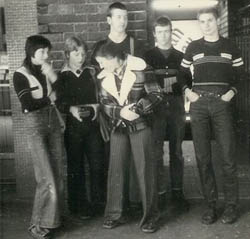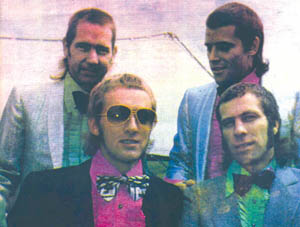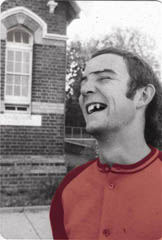Sharpies

Courtesy of Skins n Sharps; photo Stephen Egan ©
by Bruce Milne
(December 2007)
The Sharpie movement was a short-lived youth subculture that seemed to explode out of nowhere, in Melbourne, Australia, in late '72. I can still remember the moment when I first noticed the tougher kids at my school turning up in strange clothes and haircuts. It seemed that within a matter of weeks Sharpies were everywhere.It was a time of early glam-rock, kung-fu movies, Clockwork Orange. Australia was just about to ditch its conservative government and pull out of Vietnam.
The doors of the red-rattler train opened after it pulled into the station. Standing just inside was a group of Sharpies, dressed up to the nines in their best stomping gear – conny jackets, tight jeans and big platform boots. The leader of the gang stepped towards the door as a young kid was about to enter. "This train's going straight to hospital!" he said through missing teeth with a shit-eating grin. The young kid jumped back on the platform and waited for the next train.
Pete Luscombe (well-known Australian drummer and long time Paul Kelly collaborator) was the young kid in that tale. He, along with anyone else in their teens in Melbourne, Australia, in the early to mid-70's, has loads of memories of run-ins with Sharpie gangs, especially at gigs or on public transport.
My most vivid memory was, as a longhaired 16 year old, going to the Sunbury '74 rock festival in a kaftan (I know, don't snigger). Sunbury was held in the countryside (though it's now just another suburb) outside of Melbourne. I took the train. Unfortunately, so did half the Sharpies in town. I managed to make the trip alive but only after handing over whatever pocket money I had in exchange for not getting a beating.
The festival was not quite the three days of peace, love and music I had been led to believe it would be. It was dust, scorching heat, no toilets to speak of and a lot of drunk, aggressive people. Standing on a hot, dusty hill, late at night, watching Queen try to play, whilst being abused by thousands of Sharpies ("Pooftahs! Pooftahs!") and being bombarded by beer cans, I realised I was in hell. I left and hitched a ride back to town.
It was the haircuts and clothes that defined Sharpies. Though there were plenty of variations and permutations, the basic look (for boys and girls) was short hair, with longs wisps at the back, flared, high-waisted pants or jeans and a tight-fitted, striped cardigan.
Though the whole Sharpie thing was defined by a very rigid dress code, it didn't last all that long. By early '75 it was petering out. It's probably the fairly short life span of the movement that has resulted in it being so poorly documented and often mixed with misinformation.
It wasn't some remote antipodean offshoot of UK boot-boy, white-pride culture. Though there were many Sharpies who (or their parents) had emigrated from the UK, there were plenty of Sharpies from Italian, Greek, Yugoslav, Maltese and other backgrounds. There were also skinheads, usually kids from a UK background mingled in the mix. But they tended to go for a much simpler look – jeans, braces and t-shirts.
Largely, Sharpies were just bored, working-class kids from outer suburbs (that had sprung up too quickly, and with too few decent facilities and the needed infrastructure) hanging together and looking for things to do in a rapidly expanding city that was renown for its boring conservatism. As Ava Gardner is said to have commented (after coming here to film the 1959 post-nuclear film, On The Beach), Melbourne is "the perfect place to make a film about the end of the world".
Sharpies were very territorial. They named their gangs after the suburb (Broadmeadows -"The Broady Boys," Jordanville – "The Jordy Boys"), part of the suburb ("The South Blackburn Sharps"), or even the street they came from. Presumably because they were too broke or too young to own cars, they seemed to live half their lives on the trains and train stations around Melbourne. It made for some very scary travelling.
Various Sharpie gangs would congregate at Flinders Street, the main railway station, and along the little diners, like the Chew'n'Chat (which was always called the Chew'n'Spew) that dotted Melbourne's nearby Swanston St. For a while, they seemed to own that corner of town. Bowling alleys and pinball parlors were another place you could always count on running into a contingent.
Before long, Sharpies could be found in every major city, though Melbourne was always Mecca. You couldn't find the right clothes in other places. The weather probably had a lot to do with it, too. Melbourne is the only major city in the country that isn't warm almost all year long. Walking around any other city in a tight, woollen cardigan would have taken a lot of commitment.
I've since read that Sharpies evolved out of Sharps – sorta mod dressing kids in the late 60s who didn't go in for the whole cheese-cloth and sandals hippy thing. To be honest, I have no memory of Sharps. Maybe I was too young to notice them but I suspect they were a fairly small group. They certainly didn't wear the colourful and extreme clothes the '70's Sharpies are associated with.
FASHION
The Sharpie fashion takes some explanation, especially for non-Australians.
The boys' haircuts were short all over with styled (and often bleached) strands ("rat tails") hanging down the back. The girls' haircuts were often similar, though they tended to have their hair a bit longer. Red dye seemed to be very popular, too. Whenever I see the cover of Bowie's Aladdin Sane, Diamond Dogs or (especially) Pinups, I think of Sharpie girls.
The most important item of Sharpie clothing was the "Conny," a super tight, ribbed and collared cardigan. They came in a variety of colors, with stripes of a clashing colour, and they usually had a silly little buttoned belt on the back (similar to what you might find on an old waist coat). Connys were made (originally) by Thornbury (a northern Melbourne suburb) Greek tailors, F & L Conte. But before long, they were made by a number of places in Melbourne (and, later, in other capital cities). Boys and girls wore them. As their popularity grew, kids devised their own personalised colors and designs and have them made to order. I never saw one that wasn't about three sizes too small – the arms never came down to a Sharpie's wrists and the bottom of the Conny always sat high up the waist.
Under the connys, a Crestknit short-sleeved shirt, with a small collar and a 3-button neck was go. Or a T-shirt. It was really hard to find T-shirts with cool designs or band logos on them in the early '70's. But almost every shopping mall had a small booth where you could take a t-shirt and have flock (velvety) block letters glued on it. The organised Sharpie gangs always had t-shirts with their gang's name done in these. They wrinkled, flaked and peeled after a few washes. There were plenty of T-shirts with A_ /DC or SL_ DE written on them.
Thick, fleece woollen (maybe synthetic) lined jackets with a sorta tartan design were worn in colder weather. They were a similar shape to a biker jacket, with a diagonal zip up the front.
Later, in the dying months of Sharpie-dom, a knitted woollen jacket, similar to what Dave Starsky (Paul Michael Glaser) wore on the TV show Starsky & Hutch became popular.
Jeans were almost mandatory. For boys, they had to be tight Lees or Levis. If you had the money, or you were really dressing up, ridiculous Staggers jeans were the go. They had a really tight seam up the crotch that split (and highlighted) your balls. They must have been painful to wear. They often had extreme flared legs. If you ever see the back of the Buster Brown LP, Phil Judd is modelling a pair to full affect. Staggers also made a coverall (we call them overalls) version with a bibbed front and shoulder straps. God, they were ugly but I can't talk. I was happily wandering around in a burnt orange, highly flared, corduroy pair at the time.
A lot of guys also wore chequered flared pants that (I'm guessing) were inspired by Noddy Holder's (of Slade) stage wear.
Girls had more variety but the most popular jeans were really high waisted with wide flared (loon) legs that often covered the tops of their platform shoes. Denim miniskirts were also popular. Worn with colored tights and/or striped socks. Pinafore dresses, with a tight skivvy underneath were another fave.
Big platform boots were standard for boys. They were often two-coloured, in much the same way as a sunburst guitar is. They had a heavy, high heel and an exaggerated rounded toe, or a blunt, squared toe. Sometimes they were suede. There were variations in the shoe styles depending on which of the few accepted shops (Acropolis in Abbotsford made the most outrageous) they were bought from. Checking what style of shoes a Sharpie was wearing gave you a clue as to which part of Melbourne he was from. If it looked like he was from your side of town, you could be a little more relaxed. If his shoes indicated otherwise, it was a sign to run.
Girls wore platform shoes that had a solid cork base. As high as possible.
The height of the shoes meant that Sharpies walked in a sort of Herman Munster-ish way.
Another common footwear (especially for girls) was weird looking sandals called treads. The soles were old car tires and the tops were coloured, woven leather straps. Clogs were around as well.
Sharpie guys were the first males I ever saw with earrings, usually just one, small ring.
Sharpie girls had heavily plucked eyebrows and exaggerated eye make up in terrible (powder-blue, orange, ugh!) colours.
Though it was illegal to tattoo anyone under 18, it seemed that every Sharpie had an armful of tattoos. Along with colourful, professionally done tattoos, there were plenty of badly done, home-made jobs – bluebirds, teardrops and little stars. Another popular design (that you still see on older blokes) was a dotted line around the wrist with "cut here" written on the inner wrist.
MUSIC
The Sharpies loved their music tough, loud and simple. Suzi Quatro, Sweet, Sensational Alex Harvey Band, T-Rex, Gary Glitter and Bowie (as long as it was songs like "Rebel Rebel" or "Jean Genie"). But the most popular overseas group was Slade. They were probably bigger in Australia than anywhere else. "Slade Alive!" was played at every party I went to where there were Sharpies. When Slade toured with Status Quo in early '73, every gig was like a mass meeting of the Sharpie clans. Weirdly, the tour also included Lindisfarne and Caravan on the bill. I am surprised those two bands made it through the tour alive.

Lobby Loyde & the Coloured Balls
Of the local acts, the most popular were Billy Thorpe & the Aztecs, AC/DC, Buster Brown (featuring Angry Anderson, later of Rose Tattoo, and Phil Rudd, later of AC/DC), Skyhooks, and Hush. But none were more popular than Lobby Loyde and the Coloured Balls. In their short lifespan ('72–'74), they were the undisputed number one Sharpie band.
Looking back, all of the fave Sharpie songs tended to be the simple, call-to-arms anthems – "Can The Can, " "Rebel Rebel, " "Get It On," "Metal Guru," "I'm the Leader of the Gang (I Am!)," "Rock'n'Roll Pt. 2," "Jean Genie," "Ballroom Blitz," "Liberate Rock," "All The Young Dudes," "Smokin' In The Boysroom," "Speed King," "Teenage Rampage," "Framed," "Get Down and Get With It," "Mama Weer All Crazee Now," "Cum on Feel the Noize."
The Sharpies had a particular dance. They'd form small circles and bounce on their legs a bit whilst thumpin' their fists up and down in front of their bodies.
VIOLENCE
The violence that seemed to surround the Sharpie gangs was largely over-stated (especially by the media at the time). They were tough kids but mainly the fights were between rival Sharpie gangs or, along the coastal suburbs, with local surfers (who were always called Surfies). I had long hair at the time and, though I sometimes ended up having to hand over any change, I rarely felt I couldn't go to most concerts that Sharpies were bound to be at. I would regularly attend the Q Club (at the Kew Civic Centre), a weekly dance that was a short walk from my house. It was a major Sharpie haunt but I don't remember there being any major brawls. However, there were dances (the Box Hill Town Hall, the Chelsea Town Hall, the Ringwood skating rink) that I would never consider going to.
I did witness two major Sharpie battles. One was at an all day concert held at the Frankston (an outer, sea-side suburb) football ground on Boxing Day '72. It was an odd mix of bands – from prog-rock to basic boogie – and it was hot. As the day wore on, people were getting rowdier, drunker and sunburnt. Late in the afternoon, there was a sudden movement in the crowd and a brawl involving (what looked like hundreds of) people erupted in the middle of the field. Everyone was either rushing (like me!) to get away or rushing to join in. Apparently, the bouncers (Bob Jones Security – who all seemed to sport porn-star handlebar moustaches) had gotten into a bit of aggro with a small group of Sharpies and every other Sharpie there waded in to help. I only heard about that later though, because I was running in the other direction back to the train station.
The worst Sharpie brawl I saw was at a park in Richmond. It was late '72 also and there was a concert celebrating the end of the draft and our involvement in Vietnam. Lobby Loyde & The Coloured Balls were playing. Sharpie gangs came from all over. Though there were other bands on the bill, it was definitely the Coloured Balls that everyone had come to see. The band only made it through a few songs before an all-in brawl between rival Sharpie gangs broke out in front of the stage. Lobby jumped into the crowd to sort it all out and disappeared for a few minutes. When he climbed back on stage, he had blood streaming down his face. He grabbed the mic and said, "Fuck this shit, the gig's over." And it was. The fighting continued but I'd made another hasty exit.
I'm not sure why the Sharpie thing faded out. It certainly wasn't for the reason I've seen recycled many times – that punk took over. Punk never took over. It was always a small subculture in Melbourne and it was very middle-class.
I suspect it really ran its course naturally. The music that defined it was fading in popularity. The kids got jobs, got married, had kids. And the younger brothers and sisters wanted something new.
In recent years, there has been a wave of nostalgia for Sharpies. Last year, a Melbourne gallery had an exhibition of photos of the time. This was followed by the publication of a book, Top Fellas (by Tadhg Taylor) that documented the movement. Unfortunately, it sold out immediately and hasn't been reprinted. Another exhibition, Skins'n'Sharps (The Forgotten Subculture), was held that featured plenty of items of clothing, newspaper clippings from the time, photos and lots more. The Skins'n'Sharps crew now have a website that is a great starting point for info skinsnsharps.com. They are also working on a doco film.

Photo courtesy of Skins n Sharps, photo Graeme Penton ©